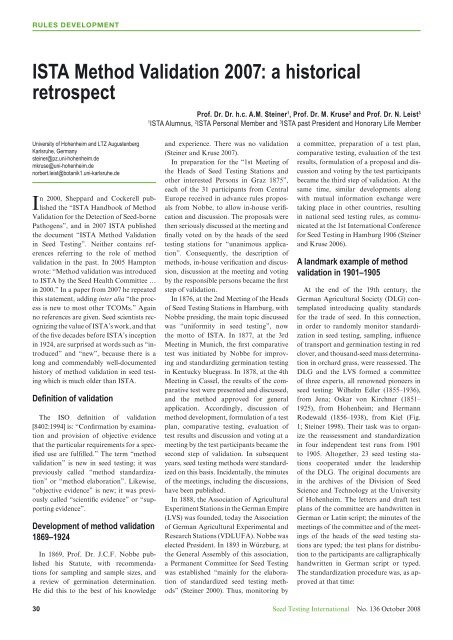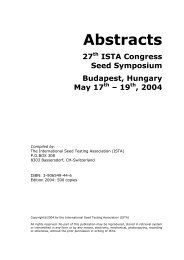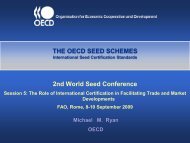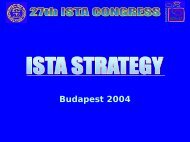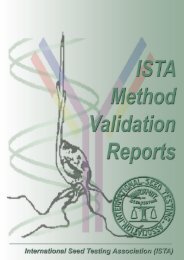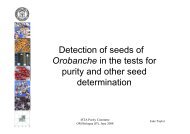(ISTA News Bulletin) No. 136, October 2008 - International Seed ...
(ISTA News Bulletin) No. 136, October 2008 - International Seed ...
(ISTA News Bulletin) No. 136, October 2008 - International Seed ...
You also want an ePaper? Increase the reach of your titles
YUMPU automatically turns print PDFs into web optimized ePapers that Google loves.
Rules Development<br />
<strong>ISTA</strong> Method Validation 2007: a historical<br />
retrospect<br />
Prof. Dr. Dr. h.c. A.M. Steiner 1 , Prof. Dr. M. Kruse 2 and Prof. Dr. N. Leist 3<br />
1<br />
<strong>ISTA</strong> Alumnus, 2 <strong>ISTA</strong> Personal Member and 3 <strong>ISTA</strong> past President and Honorary Life Member<br />
University of Hohenheim and LTZ Augustenberg<br />
Karlsruhe, Germany<br />
steiner@pz.uni-hohenheim.de<br />
mkruse@uni-hohenheim.de<br />
norbert.leist@botanik1.uni-karlsruhe.de<br />
In 2000, Sheppard and Cockerell published<br />
the “<strong>ISTA</strong> Handbook of Method<br />
Validation for the Detection of <strong>Seed</strong>-borne<br />
Pathogens”, and in 2007 <strong>ISTA</strong> published<br />
the document “<strong>ISTA</strong> Method Validation<br />
in <strong>Seed</strong> Testing”. Neither contains references<br />
referring to the role of method<br />
validation in the past. In 2005 Hampton<br />
wrote: “Method validation was introduced<br />
to <strong>ISTA</strong> by the <strong>Seed</strong> Health Committee …<br />
in 2000.” In a paper from 2007 he repeated<br />
this statement, adding inter alia “the process<br />
is new to most other TCOMs.” Again<br />
no references are given. <strong>Seed</strong> scientists recognizing<br />
the value of <strong>ISTA</strong>’s work, and that<br />
of the five decades before <strong>ISTA</strong>’s inception<br />
in 1924, are surprised at words such as “introduced”<br />
and “new”, because there is a<br />
long and commendably well-documented<br />
history of method validation in seed testing<br />
which is much older than <strong>ISTA</strong>.<br />
Definition of validation<br />
The ISO definition of validation<br />
[8402:1994] is: “Confirmation by examination<br />
and provision of objective evidence<br />
that the particular requirements for a specified<br />
use are fulfilled.” The term “method<br />
validation” is new in seed testing; it was<br />
previously called “method standardization”<br />
or “method elaboration”. Likewise,<br />
“objective evidence” is new; it was previously<br />
called “scientific evidence” or “supporting<br />
evidence”.<br />
Development of method validation<br />
1869–1924<br />
In 1869, Prof. Dr. J.C.F. <strong>No</strong>bbe published<br />
his Statute, with recommendations<br />
for sampling and sample sizes, and<br />
a review of germination determination.<br />
He did this to the best of his knowledge<br />
and experience. There was no validation<br />
(Steiner and Kruse 2007).<br />
In preparation for the “1st Meeting of<br />
the Heads of <strong>Seed</strong> Testing Stations and<br />
other interested Persons in Graz 1875”,<br />
each of the 31 participants from Central<br />
Europe received in advance rules proposals<br />
from <strong>No</strong>bbe, to allow in-house verification<br />
and discussion. The proposals were<br />
then seriously discussed at the meeting and<br />
finally voted on by the heads of the seed<br />
testing stations for “unanimous application”.<br />
Consequently, the description of<br />
methods, in-house verification and discussion,<br />
discussion at the meeting and voting<br />
by the responsible persons became the first<br />
step of validation.<br />
In 1876, at the 2nd Meeting of the Heads<br />
of <strong>Seed</strong> Testing Stations in Hamburg, with<br />
<strong>No</strong>bbe presiding, the main topic discussed<br />
was “uniformity in seed testing”, now<br />
the motto of <strong>ISTA</strong>. In 1877, at the 3rd<br />
Meeting in Munich, the first comparative<br />
test was initiated by <strong>No</strong>bbe for improving<br />
and standardizing germination testing<br />
in Kentucky bluegrass. In 1878, at the 4th<br />
Meeting in Cassel, the results of the comparative<br />
test were presented and discussed,<br />
and the method approved for general<br />
application. Accordingly, discussion of<br />
method development, formulation of a test<br />
plan, comparative testing, evaluation of<br />
test results and discussion and voting at a<br />
meeting by the test participants became the<br />
second step of validation. In subsequent<br />
years, seed testing methods were standardized<br />
on this basis. Incidentally, the minutes<br />
of the meetings, including the discussions,<br />
have been published.<br />
In 1888, the Association of Agricultural<br />
Experiment Stations in the German Empire<br />
(LVS) was founded, today the Association<br />
of German Agricultural Experimental and<br />
Research Stations (VDLUFA). <strong>No</strong>bbe was<br />
elected President. In 1893 in Würzburg, at<br />
the General Assembly of this association,<br />
a Permanent Committee for <strong>Seed</strong> Testing<br />
was established “mainly for the elaboration<br />
of standardized seed testing methods”<br />
(Steiner 2000). Thus, monitoring by<br />
a committee, preparation of a test plan,<br />
comparative testing, evaluation of the test<br />
results, formulation of a proposal and discussion<br />
and voting by the test participants<br />
became the third step of validation. At the<br />
same time, similar developments along<br />
with mutual information exchange were<br />
taking place in other countries, resulting<br />
in national seed testing rules, as communicated<br />
at the 1st <strong>International</strong> Conference<br />
for <strong>Seed</strong> Testing in Hamburg 1906 (Steiner<br />
and Kruse 2006).<br />
A landmark example of method<br />
validation in 1901–1905<br />
At the end of the 19th century, the<br />
German Agricultural Society (DLG) contemplated<br />
introducing quality standards<br />
for the trade of seed. In this connection,<br />
in order to randomly monitor standardization<br />
in seed testing, sampling, influence<br />
of transport and germination testing in red<br />
clover, and thousand-seed mass determination<br />
in orchard grass, were reassessed. The<br />
DLG and the LVS formed a committee<br />
of three experts, all renowned pioneers in<br />
seed testing: Wilhelm Edler (1855–1936),<br />
from Jena; Oskar von Kirchner (1851–<br />
1925), from Hohen heim; and Hermann<br />
Rodewald (1856–1938), from Kiel (Fig.<br />
1; Steiner 1998). Their task was to organize<br />
the reassessment and standardization<br />
in four independent test runs from 1901<br />
to 1905. Altogether, 23 seed testing stations<br />
cooperated under the leadership<br />
of the DLG. The original documents are<br />
in the archives of the Division of <strong>Seed</strong><br />
Science and Technology at the University<br />
of Hohenheim. The letters and draft test<br />
plans of the committee are handwritten in<br />
German or Latin script; the minutes of the<br />
meetings of the committee and of the meetings<br />
of the heads of the seed testing stations<br />
are typed; the test plans for distribution<br />
to the participants are calligraphically<br />
handwritten in German script or typed.<br />
The standardization procedure was, as approved<br />
at that time:<br />
30<br />
<strong>Seed</strong> Testing <strong>International</strong> <strong>No</strong>. <strong>136</strong> <strong>October</strong> <strong>2008</strong>


